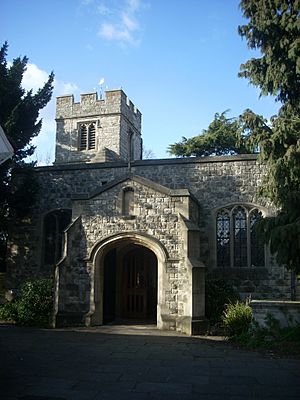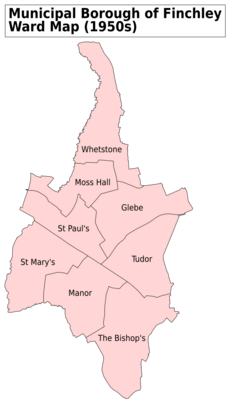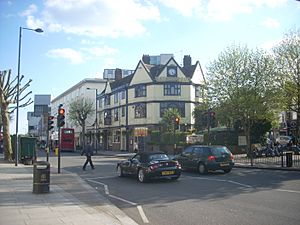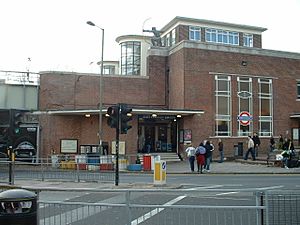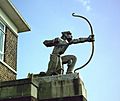Finchley facts for kids
Quick facts for kids Finchley |
|
|---|---|
 Ballards Lane, Church End, Finchley |
|
| Population | 65,812 (2011 Census |
| OS grid reference | TQ255905 |
| • Charing Cross | 6.8 mi (10.9 km) S |
| London borough | |
| Ceremonial county | Greater London |
| Region | |
| Country | England |
| Sovereign state | United Kingdom |
| Post town | LONDON |
| Postcode district | N2, N3, N12, parts of N20 |
| Dialling code | 020 |
| Police | Metropolitan |
| Fire | London |
| Ambulance | London |
| EU Parliament | London |
| UK Parliament |
|
| London Assembly |
|
Finchley is a large area in north London, England. It's part of the London Borough of Barnet. Finchley is located on high ground, about 11 kilometres (7 miles) north of Charing Cross, a famous spot in central London.
It's mostly a place where people live, with three main shopping and community areas. These are North Finchley, East Finchley, and Finchley Church End (also known as Finchley Central). In 2011, about 65,812 people lived in Finchley.
Contents
History of Finchley
The name Finchley probably means "Finch's clearing" or "finches' clearing" in old English. This name was first written down in the early 1200s. Finchley isn't mentioned in the Domesday Book, which was a big survey of England made in 1086. However, by the 1000s, the Bishop of London owned its lands.
Long ago, Finchley was mostly a forest with few people. The people who lived there supplied pigs and wood for fuel to London.
Farming started to become more common around the time of the Norman Conquest in 1066. By the 1400s and 1500s, the forests on the east side of the area were cleared to create Finchley Common. The old Great North Road went through this common. This road was famous for highwaymen (robbers on horseback) until the early 1800s.
St Mary-at-Finchley Church was first mentioned in the 1270s. A small village called East End, which later became East Finchley, started to grow by 1365. It was near the northern gate of the Bishop of London's park.
The Edgware, Highgate and London Railway (a train line) reached Finchley in 1867. It connected Finsbury Park to Edgware, passing through Finchley. A branch line from Finchley to High Barnet opened in 1872. In 1905, tram services started in Finchley, and later they were replaced by trolleybuses.
In 1933, there were plans to make the train lines through Finchley part of the London Underground. This included building a new tunnel to connect the Northern line from Archway to East Finchley. Much of this work was done, and East Finchley station was rebuilt. However, the project stopped because of World War II. All passenger trains from Finchley to Edgware stopped in September 1939. Even so, Underground trains started running from central London to High Barnet in 1940, and to Mill Hill East in 1941, to reach army barracks.
After the war, the plan to extend the Underground line further was cancelled. However, steam trains still used the line through Finchley for goods until 1964.
How Finchley is Governed
Finchley used to have its own local government. From about 1547, it had a parish vestry (a local committee). This became a local board in 1878, then an urban district council in 1895, and finally a municipal borough council from 1933 to 1965. Today, Finchley is part of the larger London Borough of Barnet.
From 1959 to 1992, the area was represented in the UK Parliament by Margaret Thatcher. She was a very famous politician who became the UK Prime Minister from 1979 to 1990. Now, Finchley is part of a new area called Finchley and Golders Green for Parliament.
Geography of Finchley
Finchley is on a flat area about 90 metres (300 feet) above sea level. It's about 11 kilometres (7 miles) north of Charing Cross and 6 kilometres (4 miles) south of Barnet. To the west, there's the Dollis valley, formed by Dollis Brook, which is the natural western edge of Finchley. Mutton Brook forms the southern edge. These two brooks join to become the River Brent.
Most of Finchley sits on a type of clay or glacial soil. The most fertile areas were along a triangular gravel line. Small villages grew at the three corners of this line, which became the main centres of Finchley today:
- Church End, also known as "Finchley Central." This area is north and west of the North Circular Road, around Ballards Lane and Finchley Central tube station. Its postcode is N3.
- East Finchley, located roughly between Highgate and the North Circular Road. Its postcode is N2.
- North Finchley, around Tally-Ho corner, stretching west to the Northern line tube line. Its postcode is N12.
Other residential areas include West Finchley (N3) and Woodside Park (N12), which are named after their tube stations.
It's important to know that the area of London called 'Finchley Road' is not actually part of Finchley. It's further south in Swiss Cottage, Camden. That area is named after a section of the A41 road that eventually leads to Finchley.
 |
Totteridge | Whetstone | Friern Barnet |  |
| Mill Hill | Muswell Hill | |||
| Hendon | Golders Green | Highgate |
People of Finchley
According to the 2011 UK Census, in the Finchley Church End area, about 67% of the people were White. About 31% of the population followed Judaism, and 28% were Christians.
Famous Places in Finchley
St Mary's at Finchley is the local parish church, and some parts of it are from the 1200s.
College Farm is the last farm left in Finchley. It used to be a modern dairy farm and then a place for visitors to enjoy. The Phoenix Cinema in East Finchley is one of the oldest cinemas in the UK that was built specifically for movies. It has a cool 1930s art deco style.
The Sternberg Centre for Judaism is in the old Manor House in East End Road. It's a Jewish cultural centre that helps different Jewish groups.
The Archer, located at East Finchley tube station, is a 3-metre (10-foot) tall statue. It shows a kneeling archer who has just shot an arrow.
Getting Around Finchley
Transport for London manages all the transport in Finchley.
Finchley has four London Underground stations. They are all on the High Barnet branch of the Northern line, which connects to central London:
- East Finchley: This station is in zone three and is about 21 minutes from Charing Cross.
- Finchley Central: In zone four, it serves Finchley, Church End, and is about 25 minutes from Charing Cross.
- West Finchley: Also in zone four, it serves North Finchley and is about 27 minutes from Charing Cross.
- Woodside Park: In zone four, it serves North Finchley and is about 29 minutes from Charing Cross.
- Whetstone: In zone four, it serves Whetstone and parts of North Finchley. It's about 31 minutes from Charing Cross.
Two major London roads, the A406 North Circular Road (east-west) and the A1 (north-south), meet at Henlys Corner on the southern edge of Finchley.
North Finchley bus station is a busy spot where many bus routes stop around Tally Ho Corner.
Schools in Finchley
There are 17 primary schools in Finchley.
There are also seven secondary schools:
- The Archer Academy
- Bishop Douglass Catholic School
- Christ's College Finchley
- The Compton
- Finchley Catholic High School
- St. Michael's Catholic Grammar School
- Wren Academy
There is also a special secondary school called Oak Lodge Special School in East Finchley.
Woodhouse College in North Finchley is a college for older students. It's on the site of the old Woodhouse Grammar School.
Sports in Finchley
The local football team is Old Finchleians, also known as the OFs. They were formed in 1901 and play their home games at The Old Finchleians Memorial Ground.
Wingate & Finchley is another football club that plays in a higher league. It was created in 1991 when Finchley Football Club (started in 1874) and Wingate Football Club (started in 1946) joined together. The club welcomes people of all backgrounds.
The local rugby team is Finchley RFC. Finchley Cricket Club, founded in 1832, plays in the Middlesex premier league. Finchley golf club was designed by a famous golfer named James Braid.
Finchley Victoria Bowls and Croquet Club is located in Victoria Park. It offers lawn bowls, croquet, and pétanque (a French game similar to bowls) in the summer.
Public Services in Finchley
Veolia Water Central Limited provides water to Finchley. EDF Energy Networks is in charge of distributing electricity to homes and businesses.
Finchley Memorial Hospital, on Granville Road, was a small hospital. A new, modern hospital was built next to it and opened in September 2012.
The London Ambulance Service helps with medical emergencies in Finchley. The Metropolitan Police Service handles policing, and the London Fire Brigade provides fire services.
Community Places in Finchley
The artsdepot is a community arts centre that opened in 2004 at Tally Ho Corner, North Finchley. It has a gallery, a studio, and a theatre.
Finchley Film Makers started in 1930, making it one of the oldest film clubs in the country.
Victoria Park is a public park off Ballards Lane. It was suggested in 1887 to celebrate Queen Victoria's special anniversary and opened in 1902. It has tennis courts and the Finchley Victoria Bowling and Croquet Club. There's also a small nature reserve nearby called Long Lane Pasture.
Avenue House was built in 1859. In 1874, it was bought by Henry Charles Stephens, who was famous for his "inky" Stephens ink. When he died in 1918, he left the house and its grounds for "public enjoyment." This place is now known as Stephens House and Gardens.
It has a visitor centre with a small museum called the Stephens Collection. This museum tells the story of the Stephens family, their ink company, and the history of writing. The gardens were designed by a famous landscape gardener. They have a tearoom, a playground for children, a walled garden, a pond, and rare trees. A popular new addition is a bronze statue of the comedian Spike Milligan sitting on a bench.
Notable People from Finchley
Many interesting people have lived in or come from Finchley:
- Margaret Thatcher (1925–2013), who was the UK Prime Minister from 1979 to 1990, was the Member of Parliament for Finchley from 1959 to 1992.
- Spike Milligan (1918–2002), a famous comedian and writer for "The Goon Show," lived in Woodside Park. His statue is at Stephens House and Gardens.
- Harry Beck (1902–1974), who designed the famous London Underground Tube map in 1931, lived in Finchley. There's a plaque for him at Finchley Central tube station.
- George Michael (1963–2016), the well-known singer, was born in East Finchley.
- Emma Bunton (born 1976), a singer and member of the Spice Girls, was born in Finchley.
- Demis Hassabis (born 1976), a leading artificial intelligence researcher who founded DeepMind, grew up in Finchley.
- Jacob Collier (born 1994), a talented composer and musician, lives and records music in Finchley.
- John Bercow (born 1963), who used to be the Speaker of the House of Commons, grew up in Finchley.
- Vera Lynn (1917–2020), a beloved singer, lived in Finchley in the 1950s and 1960s.
Twin Towns
Finchley used to have four twin towns, and the London Borough of Barnet still keeps these connections:
 Jinja, Uganda, since 1963
Jinja, Uganda, since 1963 Le Raincy, France, since 1962
Le Raincy, France, since 1962 Montclair, United States, since 1945
Montclair, United States, since 1945 Siegen-Wittgenstein, Germany, since 1951
Siegen-Wittgenstein, Germany, since 1951
Gallery
See also
 In Spanish: Finchley para niños
In Spanish: Finchley para niños



